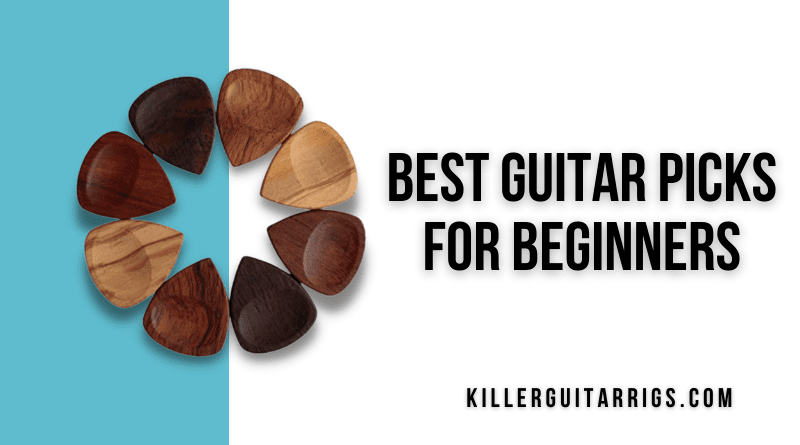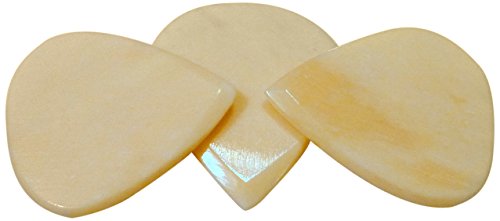I recently spoke to a producer who told me the thing he does when someone is having trouble nailing a part is to swap out their pick.
You only touch the guitar with one hand – the fretting hand. Your other hand touches the guitar with a pick, so the ability you have to translate your music into the pick and the ability of the pick to relate your music to the strings are 50% of the job of playing guitar.
Nowhere is this more true than for beginners – when you’re new to the guitar, you need every accommodation you can get until you build the skills to play beyond the gear you’re using.
Will the pick be the difference between you giving up and you becoming the musician you dream of? Don’t let it be.
Read more about our review process.
Contents
Our Top 3 (Multipacks)
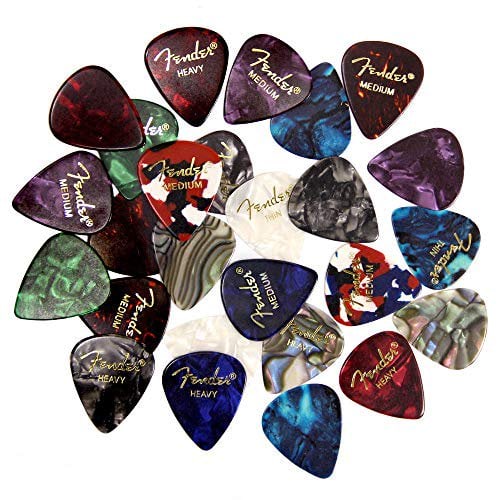
Fender Premium Picks Sampler
Great quality and a good selection of sizes for all occasions
This multipack of celluloid picks comes in an array of awesome colors and gauges, and is perfect for finding out which size suits you best before stocking up.
Fender’s Premium Picks Sampler is a smorgasbord of the ‘go-to’ picks of many guitarists and even professional musicians like Angus Young. It includes top-quality celluloid picks of a regular size with an imprinted Fender logo along the side. The pack includes a random assortment of colors like green, blue, white, red, black, and others.
Priced slightly over ten dollars, you receive eight thin, medium, and heavy gauge guitar picks, making a total of 24 high-quality guitar picks. The heavy gauge picks can be used for playing riffs and solos, and the thin picks are ideal for jangly strumming. The medium picks, on the other hand, are good all-round picks for beginners.
With nearly 5k+ five-star reviews, it seems like the market echoes our positive sentiments. At the time of this review, this product was also featured as Amazon’s Choice in the category. This pack doesn’t include a pouch/tin for storage, but you can buy the Fender Keychain Leather Guitar Pick Holder as an add-on purchase. Overall, the top-notch material, comfort, and feel of the picks prompted us to select this as our Top Choice for the best guitar picks for beginners. It is hard to go wrong with these unless you have hands like Hagrid.
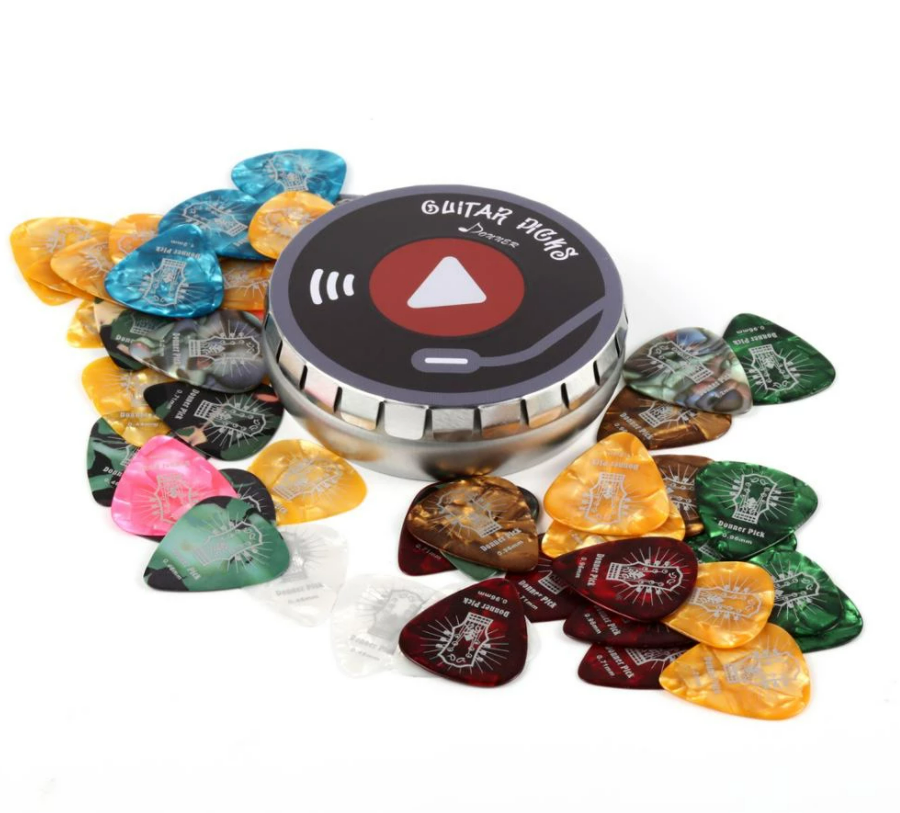
Donner Celluloid Guitar Picks 48 Pack
Excellent value and strong performance.
Low cost doesn't always have to mean low quality. These Donner picks come in a great range of sizes and even have an embossed logo to improve grip.
For under $10, Donner offers a nifty tin box with 48 guitar picks of four assorted thicknesses. The thin picks are 0.46mm, the medium ones are 0.71mm, the heavies are 0.96, and the extra heavy picks are 1.2mm.
As the name suggests, these picks are made from smooth celluloid with an imprinted logo to improve grip. They are regular-sized picks with standard-quality material, curved tips, and a smooth finish.
Compared to the D’Addario or Fender Pack, you receive nearly twice the amount of picks with a click-open tin box for two-thirds the price. This pack is loaded with value, and it is a no-brainer for anyone who just wants a bounteous box of standard-quality guitar picks. For these reasons, we’ve featured this as our Best Budget Option.
These guitar picks are easy to grip, and thanks to the four levels of thickness, you can find something that will work in every imaginable musical context. We have encountered other Donner products and even featured some of them in our Best Guitar Wall Mount Hanger list and Best Electric Guitar Starter Kits guide. It seems they are a mainstay in the budget segment, and for good reason.

D'Addario Pearl Celluloid Guitar Picks
Premium picks that look good, feel great, and sound even better
For premium quality celluloid picks look no further. These are extra heavy, and are perfect for fat tones, and awesome stability and accuracy.
D’Addario is a name we’ve come to trust when it comes to a wide variety of guitar accessories. They don’t disappoint with their proprietary “pearl celluloid” picks either. The pack includes eight white pearl 0.50mm picks (light), nine red 0.70mm picks (medium), and eight black 1.0mm picks (heavy). The product can include ten blue pearl 1.25mm picks as an add-on purchase.
The flexibility of this pack is what stood out when we were comparing it to similar options. On the Amazon listing, you can order 10, 25, or 100 picks of 4 different thicknesses (light, medium, heavy, and extra heavy), or you can get a combo of light/medium/thick as an assorted pack. They allow you to customize the pack with add-ons, and unlike most other packs, you can select the colors. These American series guitar picks are absolutely gorgeous, comfortable, and highly articulate picks at a reasonable price. And, for those who care, the Planet Waves packaging is eco-friendly and designed for minimal environmental impact. With ideals like those, it is compelling to reward the quality and thoughtfulness of this product with our Editor’s Choice for beginner guitar picks.
Our Top 3 (Individual Picks)
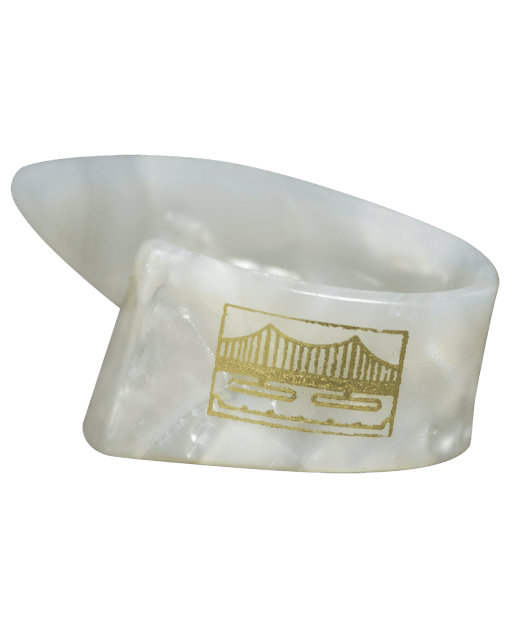
Golden Gate Pearloid GP-6
Comfortable picks that also happen to be virtually indestructable.
These thumb picks are ideal for players who tend to play hard. They stay in place, provide great nuaunce, and outlast almost everything else.
For anyone who is really into thumb picks, the Golden Gate Pearloid Thumb Pick is where it’s at. Although they are relatively expensive, the vintage styling, durable construction, and heavy pearloid nitrocellulose material easily vindicate the price tag. They may seem wide on the string end, but you can always file them down to your preference.
If you want a more budget-friendly option, you can get the Dunlop 9002P or the Dunlop 9073P Ultex picks. However, if you are just curious and looking for a throwaway pack to explore the technique, Planet Waves Shell Celluloid Thumb Picks will easily get the job done.
By the way, if you’re not familiar with thumbpicks, check out our guide on when to use a thumbpick, along with some additional recommendations.
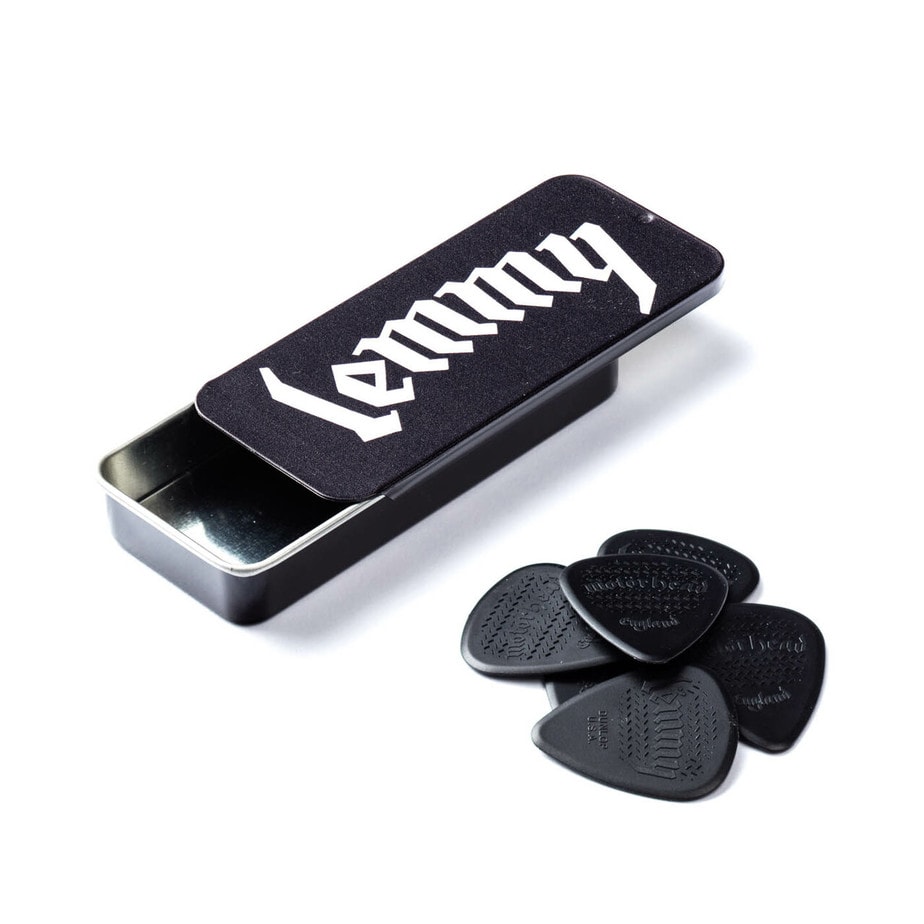
Dunlop MHPT02
High end bass picks with incredible grip and big tone.
If you're trying to get more bite from your bass tone, pick up these picks. They feature a textured surface for grip and the contoured edges offer excellent attack control.
Trying to play the bass guitar with a thin or medium guitar pick can often feel like flying a kite using a cobweb. You need a stubby bass pick that can endure the additional thickness of your strings and lend its grit to the groove.
The Dunlop MHPT02 comes to my mind, thanks to the late great Lemmy Kilmister, who taught us a thing or two about chugging in the glory days of Motorhead. These 1.14mm all-black nylon monsters ship in a Lemmy-branded collectible tin. They are available as a six-pack of nylon picks with a raised tip. They feel naturally comfortable and provide a good grip.
You can also select between the Album Art version (0.73mm Tortex picks) – which is perfect for Lemmy fans – and the Warpig version (0.88mm Tortex picks). And despite the branding, they are versatile enough to pull off anything from Paul McCartney to Bobby Vega.
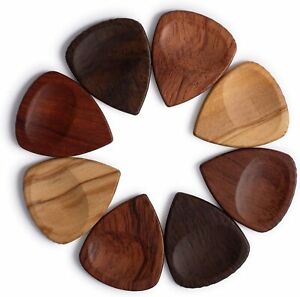
TimbreGear Genuine Exotic Wood Guitar Picks
Wooden picks with unique tones and wonderful feel.
With these beautiful exotic wood picks you're getting a warm, rich tone unmatched by any plastic picks. They are contoured for comfort and grip, and are surprisingly hard wearing.
The TimbreGear 8 Pick Pack includes rosewood, sandalwood, ebony, and olive wood guitar picks – two of each – in an elegant tin-can-styled guitar pick holder.
As guitarists, there is something about natural wood that makes us go weak in the knees. The wooden picks are gorgeous, perhaps too gorgeous to use for anything other than display purposes. That being said, these are functional picks that can produce plush tones.
However, they are quite thick and not the first thing you’d want to use for campfire strumming. The thumb groove is deep and allows you to grip it with confidence. They sound rich and warm when used with a steel or nylon string guitar. And, you can find a use for them playing a bass guitar (preferably with flat wound strings) as well. They may seem a little erudite for the beginner, but a pack like this can be an excellent gift for a musician or an interesting sonic experiment as you progress.
Are wood guitar picks good?
Wood picks have a rich and vibrant tone compared to other materials like nylon and tortex. However, they are rigid and lack flexibility. They have a learning curve, but once you adjust to the hard material, you can create some rich and unique tones.
You won’t find a thin or medium wood pick because they can be prone to cracking or chipping. However, US Blues Flex Woods picks are an interesting option that can suit all guitar types (more on guitar types). Since wooden guitar picks lack the sharp attack of conventional picks, they tend to sound earthy and warm when you strum an acoustic guitar. The true character of wooden picks surfaces while playing licks and notes.
Best Stone Pick: StoneWorks 100% Natural Stone Guitar Pick
StoneWorks are known for making unconventional but highly functional guitar picks. These stone picks are a testament to their artistry.
This isn’t a collector’s item – they may not be as common as other materials, but they are certainly functional and useable for electric guitar riffs and solos.
These ‘jazz shape’ guitar picks are handcrafted from natural stone and meticulously beveled and polished in Iowa, USA. Each pick is unique because the texture of the stones is 100% natural and varies in every rock used.
The surface of the plectrum is nearly frictionless, but the small size makes it impervious to slipping unless you have very sweaty hands. The StoneWorks stone guitar picks are unique, gorgeous, and functional – they can certainly find regular use among electric guitar players.
Are Stone guitar picks good?
Stone guitar picks have a crunchy and well-defined tone that sounds great in genres like rock, metal, and blues. Besides tonal clarity, they are eye-catching and last longer. However, they are “luxury picks” because a single pick can cost between $10 to $30.
It is rare to find stone picks in local guitar stores because of the low demand and the high cost. They may not be as common as nylon or plastic picks, but they are just as safe. They don’t damage the strings due to the curved tips, but if you aren’t careful, you can scratch the body paint.
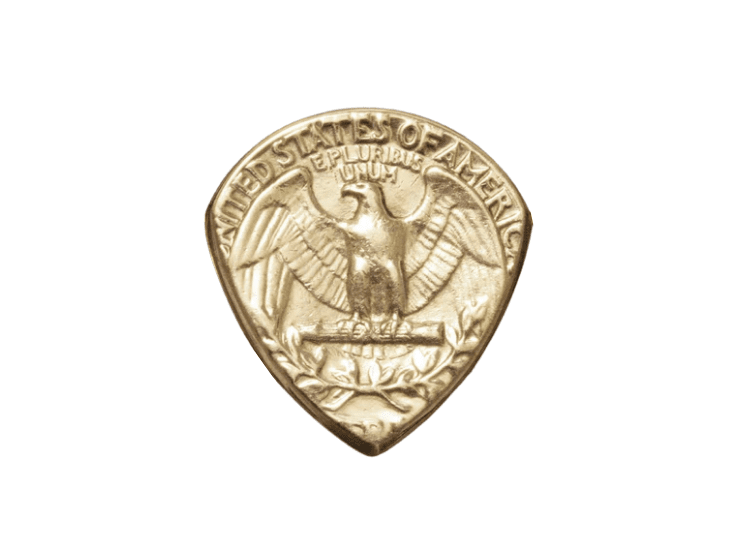
Quarter Guitar Pick
A handmade metal pick crafted from a genuine US 25 cent coin.
Metal picks like these are renowned for huge volume and unbeatable sturdiness. This one happens to be made from a Quarter coin, which really ups the cool factor, too.
This pick has George Washington on the front and the American Eagle on the other. GitGoods Quarter Guitar Picks are made from real American quarters that are hand-crafted into plectrums upon order.
They have polished and beveled edges, and the natural texture of the metal makes it really easy to grip them. If you want something more conventional, opt for the Dunlop Stainless Steel Picks or the US Blues Big West (Aluminum).
Are metal guitar picks good?
Metal picks are the least commonly used material for guitar playing. They are great for aggressive playing and articulate lead lines, but they lack flexibility and may wear out your strings faster. Conversely, they yield dynamic tones and will last forever or until you misplace them.
These plectrums would sound best with an electric guitar. They should be paired with a thicker gauge of strings. Brian May (Queen) has used a British Sixpence for most of his career, and Billy Gibbons (ZZTop) also used a Mexican peso in many of his performances.
How to Choose The Right Picks For You
The earliest guitar picks (then called plectra) were made out of hand-cut goose feather – the same material used to make feathered quills that those wig-wearing geeks used for writing in the 19th century. After the bird feathers fell out of style, humans turned to sea turtles to fashion the next generation of guitar picks.
Many Atlantic hawksbill turtles were martyred to create tortoiseshell picks and pickguards. There came a point when they were on the brink of extinction. Luckily (for the turtles), an American inventor named Tony D’Andrea figured out a way to use celluloid to make guitar picks that were superior, cheaper, and didn’t involve chasing turtles.
Since then, manufacturers have come up with all kinds of polymers – good and great – to create patented materials and designs. Today, you can choose from ultex, tortex, nylon, celluloid, pearl celluloid, metal alloys, exotic wood, etc. A long way from bird feathers, indeed. Let us look at the important design aspects that matter when selecting a guitar pick –
Material
Celluloid, nylon, and acetal are the most popular choice of materials among guitar picks. Nylon, being the most flexible, has a soft feel and textured grip. Most intermediate and advanced guitar players prefer nylon picks for electric guitar playing. Celluloid is slick and a tad less flexible. It is another popular choice that is comparable to nylon.
Acetal picks are a solid choice for all styles of guitar playing. They mimic the gritty magic of the original tortoiseshell picks. Different brands have trademarked different names of these polymers, so it can get really confusing, i.e., Dunlop “Tortex” guitar picks are made from acetal.
Size
The size directly impacts the gripping surface and the distance between the guitar string and your hand when you play the guitar. Smaller picks make it easy to execute certain techniques like right-hand (fretting-hand) palm muting, chicken picking, and pinch harmonics.
However, a smaller pick means a smaller gripping space, which can be an uncomfortable situation for beginners. This isn’t the only pick you’d want to have at a campfire unless you can lighten your touch to use it effectively for strumming Wonderwall.
Texture
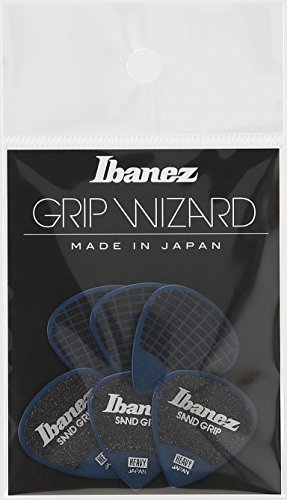
Believe it or not, flying picks have plagued musicians since antiquity. This issue prompted 19th-century musicians to dabble in all sorts of DIY fixes to stop picks from slipping during a performance. These hacks include using cork or rubber disks, drilling a hole in the pick, or corrugating the surface to improve grip.
This way or that, finding a reliable way to sink the fingerprint into the surface has always been an important consideration. Today, the textured surface of guitar picks creates enough friction to improve grip. For instance – the Ibanez Wizard Series has a no-slip sand grip to ensure that the pick doesn’t slip out of your hand. The Dunlop Max-Grip has ‘proprietary’ Max-Grip Technology – which is an engraved crisscross pattern to create an abrasive surface to prevent slipping.
Most new-age guitar picks eventually settled on a high-relief imprint – an ingenious way to push the brand logo. Nevertheless, if you don’t want to get a pick specifically for the gripping aspect, you can always get an aftermarket stick-on like Monster Grip, or if you’re feeling yucky… err lucky… you can try some Gorilla Snot.
Thickness
There will come a time when you realize a regular-sized thin pick with a curved tip isn’t the best choice for those Zakk Wylde style pinch harmonics, or a thick Dunlop Nylon Jazz III may not be ideal for acoustic strumming…
The thickness of a pick is an important factor in the tone you achieve from striking the strings. Thick picks produce a warm and dark sound, while thin picks lean towards bright and airy. Thin picks are very flexible but frail – good for clean and comfortable strumming, but they lack the rigidity required for striking notes with conviction. Thick picks have a better grip and offer greater control over dynamics while playing heavy, distorted sounds and fast solos.
- Thin Guitar Picks: 0.40mm to 0.60mm
- Medium Guitar Picks: .60mm to 0.85mm
- Heavy Guitar Picks: 0.85mm to 1.20mm
- Extra Heavy Guitar Picks: 1.20mm+
*Thickness range and rating may vary slightly among different manufacturers.
Shape
If you look hard enough, you will find everything from a ‘shark-fin’ guitar pick to a ‘Pick of Destiny’. The stranger the shape, the sharper the decline in functionality. As a beginner, I would recommend you stick to a standard shape until you get the hang of strumming and note-playing.
The standard shape has two variations – a curved tip and a pointed tip. The pointed tip is better for solo playing, and the curved tip allows the pick to glide across the strings more smoothly when you are strumming. Each type can do a decent job on the whole, but as you progress, you will favor one over the other based on the musical context you find yourself in.
Final Thoughts
Picking guitar picks for you to play licks might sound picky or persnickety, but guitar picks are an inconspicuous element in the feel and comfort of guitar playing. We hope this guide helped you ‘pick up’ the salient aspects of plectra and inspired you to load up with a box full of essential (and a few ornamental) picks. After all, having a functional pick for the stage is one thing, but bragging about an exotic handcrafted sandalwood pick in the green room is another.

